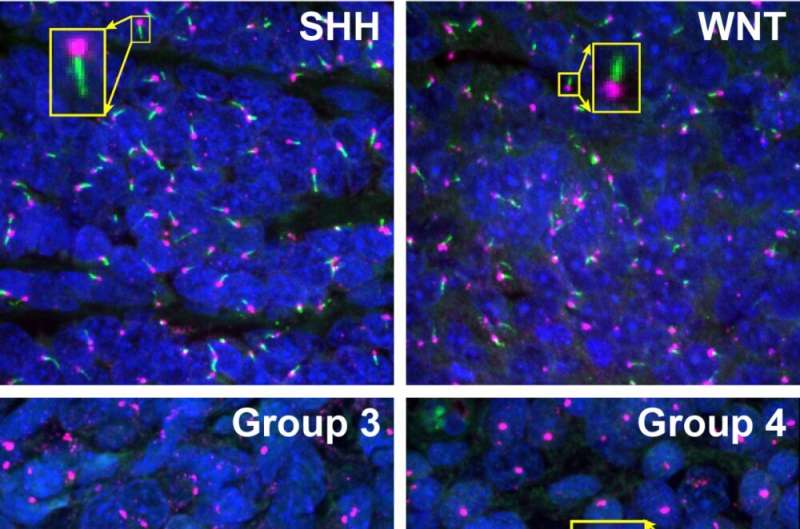The primary cilium is an appendage located on the surface of cells. Here you can see samples of human medulloblastoma representing SHH, WNT, Group 3 and Group 4. The medulloblastoma cells are pictured in blue. In SHH and WNT you can see primary cilia (green lines) that grow from the basal body (magenta dots) on their surface. These green structures are not present in Group 3 and Group 4. Yellow insets show high magnification images. Credit: St. Jude Children's Research Hospital
Scientists at St. Jude Children's Research Hospital have identified how an appendage on the surface of cells, called the primary cilium, contributes to certain types of medulloblastoma. The study has implications for drug development. The research appeared today in Genes & Development.
Medulloblastoma is the most common malignant childhood brain tumor. There are four subgroups of medulloblastoma: SHH, WNT, group 3 and group 4. SHH and WNT tumors are driven by mutations in their namesake signaling pathways, but group 3 and group 4 have no common driver mutations other than MYC amplification in about 17% of group 3 medulloblastoma. Each group has distinct molecular, pathologic and clinical features.
The primary cilium is a signaling appendage projecting from the surface of cells. It helps control the cell's function and behavior. The presence or absence of primary cilia is a notable feature in different diseases including cancer. How this appendage contributes to cancer development and growth is understudied in most tumors.
"Primary cilia are structures that were discovered over 100 years ago, but we are still coming to appreciate the role that they play in human health and disease," said corresponding author Young-Goo Han, Ph.D., St. Jude Department of Developmental Neurobiology.
Present or absent, primary cilia still have an effect
The researchers evaluated over 100 cases of human medulloblastoma and found that primary cilia are abundant in the SHH and WNT groups, but rare in group 3 and group 4.
Han established the role of primary cilia in SHH medulloblastoma in previous research. Less is known about cilia's role in the other groups. Using mouse models of WNT and group 3 medulloblastoma, the scientists revealed primary cilia can either promote or suppress cancer depending on their underlying mechanisms of action.
"We found that in WNT tumors that have primary cilia, those cilia are aiding tumor development," Han said. "In group 3 tumors where the primary cilia are missing, those cilia act as a tumor suppressor, so their absence is what contributes to the cancer."
Mechanisms provide basis for new treatment approaches
In WNT medulloblastoma, primary cilia facilitate the translation of mRNA encoding β-catenin, which is part of a protein complex involved in signaling in the WNT pathway. Results from Han and his team suggest a molecule that targets the RNA binding proteins that regulate translation of β-catenin should be explored to treat WNT medulloblastoma.
In group 3 medulloblastoma, a lack of primary cilia disrupts cell cycle control and destabilizes the genome by abnormally activating CDK1. Previous research by St. Jude investigators supports the notion that targeting factors associated with the cell cycle could potentially treat medulloblastoma.
Group-specific therapies such as these would be useful because current patients with medulloblastoma generally receive the same treatments (surgery, chemotherapy and radiation). The findings also suggest that translation and cell cycle are mechanisms worth investigating in other diseases that involve primary cilia (ciliopathies).
"These findings have implications beyond cancer to other ciliopathies where there may also be a disruption of translation or the cell cycle. These latest results are worth investigating in these very diverse human diseases that affect people from their brains to their toes," Han said.
More information: Yong Ha Youn et al, Primary cilia control translation and the cell cycle in medulloblastoma, Genes & Development (2022). DOI: 10.1101/gad.349596.122
Journal information: Genes & Development
Provided by St. Jude Children's Research Hospital
























